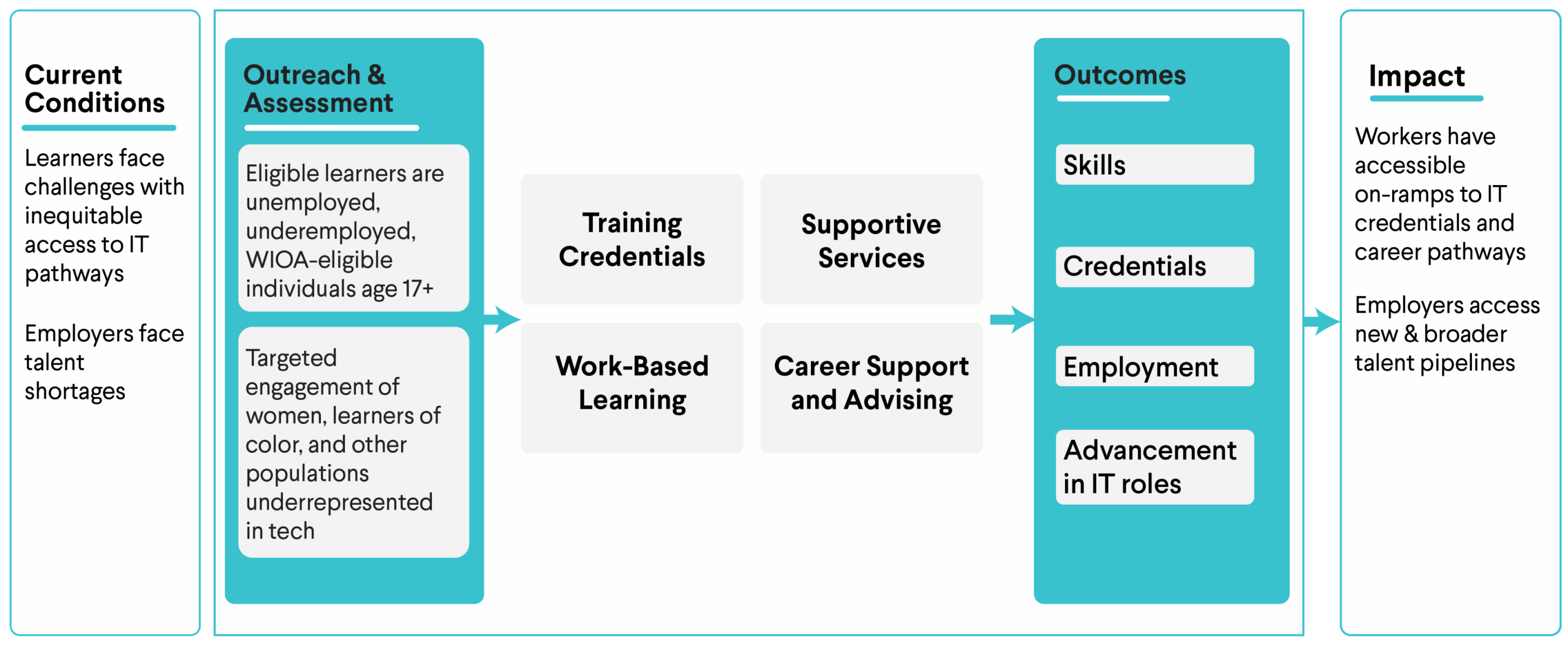

July 31, 2025
At a Glance
Accessible market-driven IT training programs must couple skills development with hands-on experiences and supportive services to ensure job-readiness. These programs should incorporate work-based learning opportunities developed through cornerstone employer partnerships.
Beyond Access and Affordability: Insights from Piloting a Virtual A+ Training Model
The digitization of business, the large-scale adoption of artificial intelligence (AI) and the Internet of Things (IoT) tools, and the rise of remote work during the early years of the pandemic led to a steady increase in demand for IT workers over the last ten years (Deloitte). While much of this growth was concentrated in IT occupations that require a four-year degree, such as programmers and developers, entry-level roles, including IT support, also expanded rapidly. From 2010 through 2023, Computer User Support Specialist jobs grew 52% and Computer Network Specialists grew 11%, highlighting opportunity to expand on-ramps to these roles (Lightcast. Data extracted by JFF, 2020-2024).
To address this demand, JFF established the Rapid IT Training and Employment Initiative (RITEI), a model that brought high-quality, short-term training to scale in 2021, backed by an H-1B One Workforce grant. This grant brought together JFF’s experience leading innovative digital jobs programs and pathways with industry leader CompTIA as the primary training provider. In addition, the National Association of Workforce Boards and the AFL-CIO’s Working for America Institute partnered with JFF to connect to local workforce boards and state and local organized labor, respectively.
By integrating industry-aligned virtual credentials, including the Google IT Support Professional Certificate and the CompTIA A+ Certification with local supportive services in four communities, JFF aimed to expand on-ramps to IT roles for underemployed and unemployed workers and provide upskilling and reskilling opportunities for incumbent workers to advance. The initiative was built on JFF’s vision of making high-value tech training—like boot camps accessible to more jobseekers by removing barriers of location and cost.
The RITEI Action Guide examines the intention, process, outcomes, and lessons learned by implementing RITEI training program for entry-level IT roles over the last four years. It highlights the lessons learned from this initiative and recommendations to improve future iterations of IT-career on-ramp training programs. Read the full Action Guide to gain insights into how practitioners can strengthen IT programs and sign up to stay up to date on future thought leadership from JFF focused on digital jobs.
"...a successful comprehensive, scalable model like RITEI must prioritize both skills development and practical experience to ensure participants are job-ready."
Understanding the RITEI Model
The RITEI model “stacked” the Google IT Support Professional Certificate with the CompTIA A+ Certification to ensure that learners had foundational knowledge in IT before embarking on the more rigorous A+ training. A+ has been the most sought-after qualification for entry-level IT jobs since 2020. Training was delivered virtually to make it accessible to more learners. Four high-impact implementation sites, Colorado Community College System (Denver), JEVS Human Services (Philadelphia), Metropolitan Community College (Omaha), and TechSF (San Francisco) piloted the RITEI model to address the urgent need for entry-level IT talent in communities facing barriers to accessing IT career on-ramps and implement the RITEI model, including participant recruitment, assessment, training and career supports, wraparound services, and connections to IT-related employment.

Outcomes and Insights
While the implementation partners enrolled over 1,000 jobseekers into training programs, training completion and post-training employment rates remained low. These outcomes indicated that to increase access to early-career IT support roles, programs must offer substantive supportive services, hands-on learning opportunities, and make connections with committed employers who can both advise program design and support employment outcomes.
 Though nearly half of all RITEI learners entered the program with a postsecondary degree and 65% had at least six years of work experience, the IT support experience gap between their resumes and employer expectations remained when learners began looking for IT-related employment after training completion. Work-based learning opportunities, though a part of the RITEI model, were challenging to get off the ground due to local market shifts and changing employer needs. This left RITEI learners without the experience and expanded professional networks they needed to more readily obtain the IT support jobs they were seeking.
Though nearly half of all RITEI learners entered the program with a postsecondary degree and 65% had at least six years of work experience, the IT support experience gap between their resumes and employer expectations remained when learners began looking for IT-related employment after training completion. Work-based learning opportunities, though a part of the RITEI model, were challenging to get off the ground due to local market shifts and changing employer needs. This left RITEI learners without the experience and expanded professional networks they needed to more readily obtain the IT support jobs they were seeking.
Despite difficulty in connecting RITEI learners to employment, when surveyed, many learners indicated they still felt hopeful about their job prospects after completing RITEI training. This reinforces that programs like RITEI can provide the support IT jobseekers need to make meaningful progress toward their career goals.
“This initiative underscores the importance of an inclusive, sustainable approach to workforce development that truly empowers individuals and responds to the demand for skilled IT professionals.”
Recommendations
Creating more effective pathways for unemployed and underemployed jobseekers from virtual IT training through regular employment requires an approach that deploys multiple coordinated interventions throughout the learner journey. Future virtual IT Training to employment programs should offer enhanced intake assessments, learner supports including financial compensation, work-based learning opportunities throughout the programs and employer engagement beginning at the program development stage.
JFF makes the following recommendations for those seeking to expand on-ramps to IT support roles for more jobseekers:
Assessing Readiness and Fit
Virtual IT training programs should integrate a multifaceted approach to assessment that identifies a potential learner’s:
- Basic digital literacy and technical knowledge
- Postsecondary degree and/or experience
- Ability to commit to the time required for training success
- Interest in and aptitude for IT support careers
Remove Barriers Beyond Location and Cost
Learners need more than just access to free virtual programs to successfully complete training and find relevant employment. To better support learners, ensure the correct resources are in place:
- Braid and leverage organizational resources to offer learners compensation and ensure that they don’t have to choose between training and work.
- Integrate cohort-building activities to establish peer support networks.
Bolster Learning Outcomes Through High-Impact Learning Supports
Outcomes for self-guided and self-paced training models can be improved by:
- Providing access to hands-on labs, not just virtual activities, to build learners’ confidence and proficiency with real-world hardware and scenarios.
- Using “push” strategies to intervene at strategic points in the program to mitigate stop-outs.
Bridging the IT support Experience Gap With Work-Based Learning
Increase employment rates for learners who obtain a credential by:
- Infusing WBL opportunities at key touchpoints throughout the course, ideally during training and after completion.
- Stacking work-based learning opportunities of varying length and intensity.
- Incentivizing employers to offer paid, supported work-based learning opportunities.
Planning Ahead for the Transition from Training to Employment
Securing the learner to employment pipeline during program planning and pressure testing the pipeline to ensure strong employment outcomes by:
- Regularly assessing and calibrating programs to regional labor market needs.
- Establishing IT employer advisory boards to align training with local needs.
Conclusion
Broadening pathways into IT careers requires a blend of skill development and hands-on experience to adequately prepare learners for the workforce. Programs must fully assess learner readiness and commitment and deploy adequate wraparound supports and job-readiness strategies, such as lab time and work-based learning opportunities. Programs can ensure increased learner success in finding quality jobs by fostering strong employer partnerships early in the planning process. Evolving the RITEI model by incorporating these recommendations will improve access to IT careers for a more diverse group of job seekers.
Learn more about RITEI and JFF’s Digital Jobs Strategy

Rapid IT Training and Employment Initiative (RITEI)

JFF Digital Jobs Strategy
—
This workforce product was funded by a grant awarded by the U.S. Department of Labor (DOL)’s Employment and Training Administration (ETA). The product was created by the recipient and does not necessarily reflect the official position of DOL/ETA. DOL/ETA makes no guarantees, warranties, or assurances of any kind, express or implied, with respect to such information, including any information on linked sites and including, but not limited to, accuracy of the information or its completeness, timeliness, usefulness, adequacy, continued availability, or ownership. This product is copyrighted by the institution that created it.

